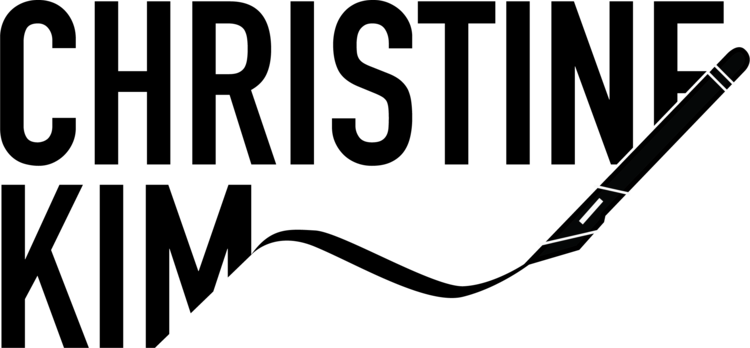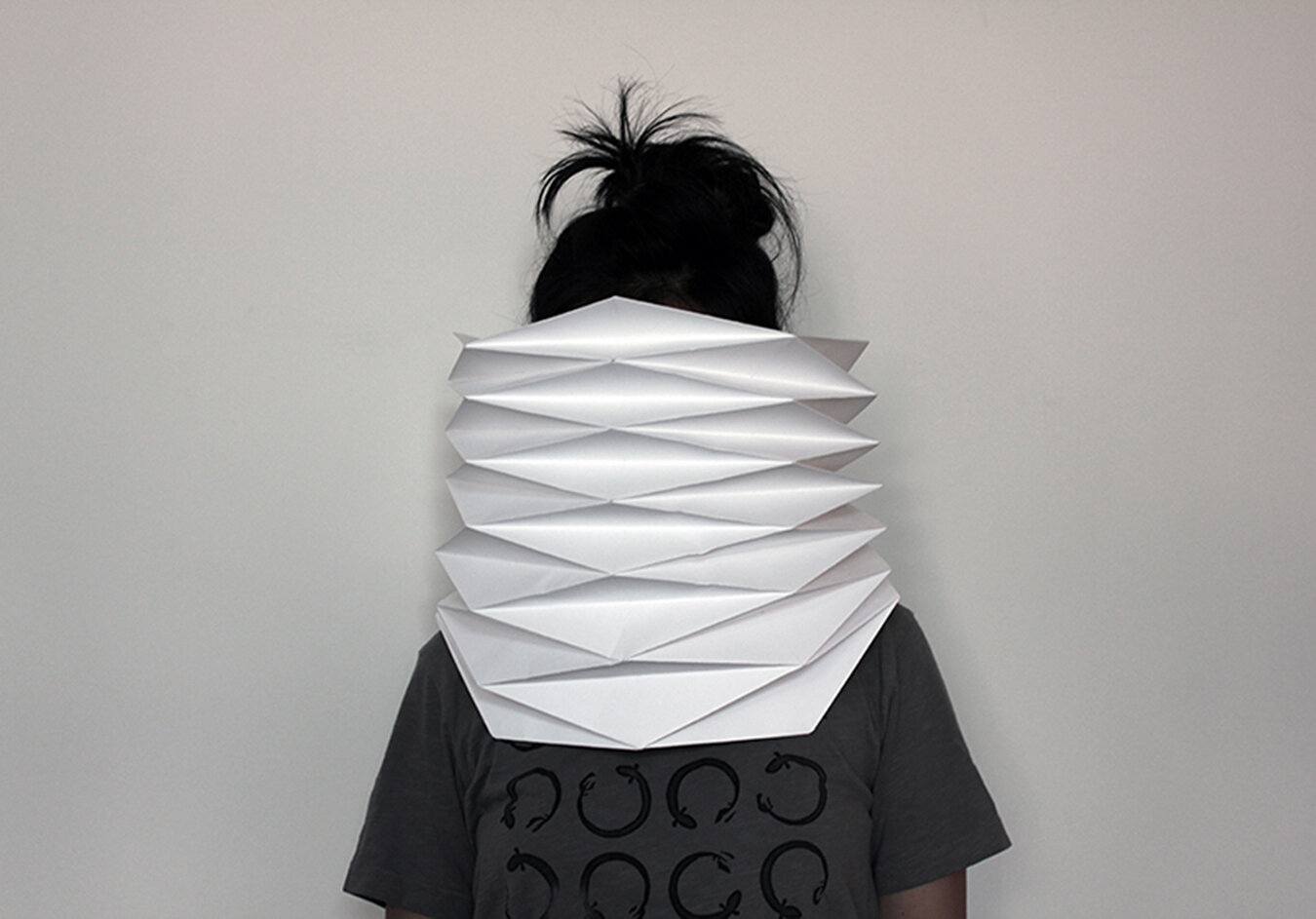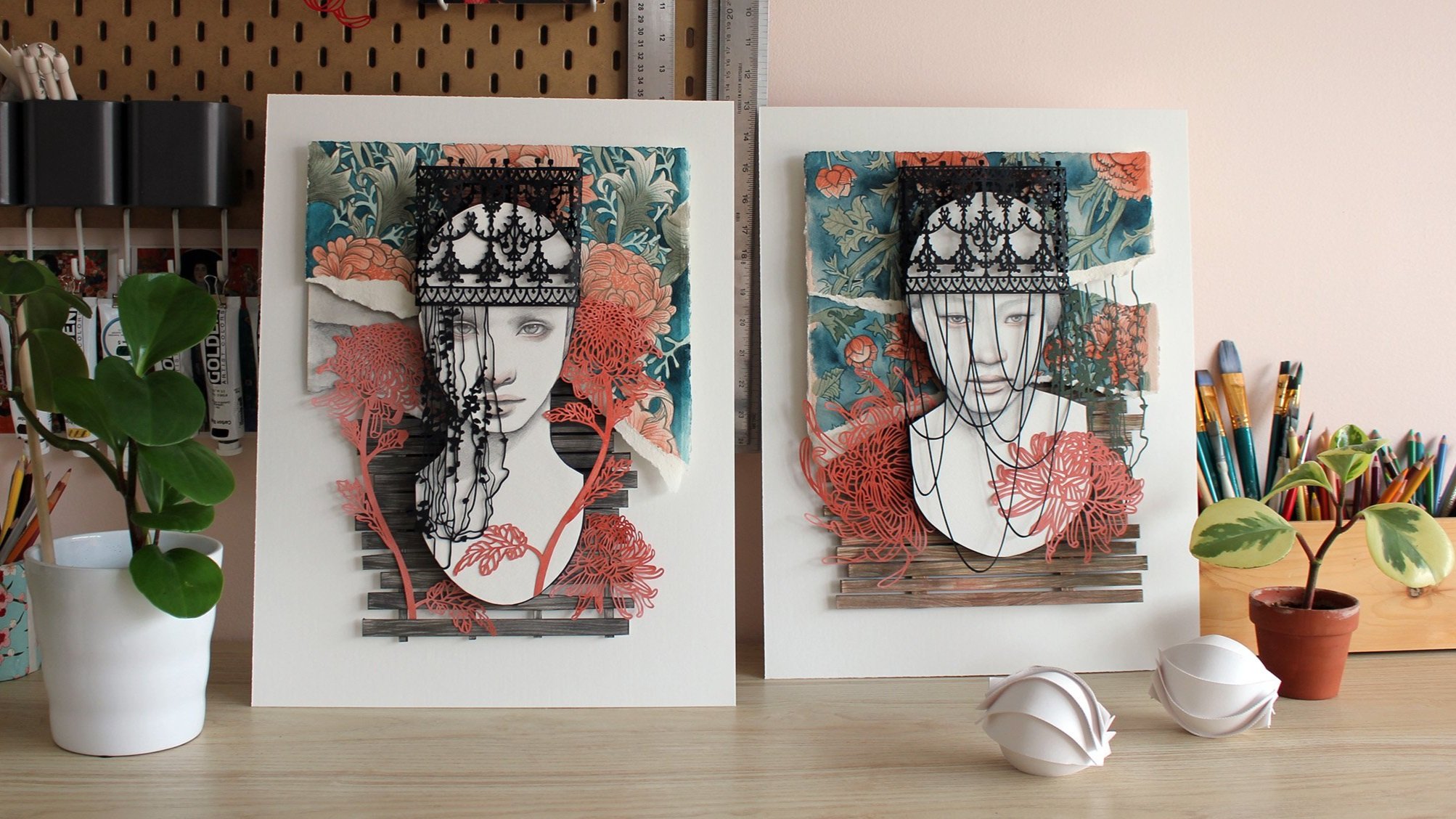CHRISTINE KIM is a Toronto-based artist who works primarily in cut paper art, carving away the boundaries between illustration and sculpture.
about me
CHRISTINE KIM is a Korean-Canadian paper artist. She lives and works as an artist and arts educator north of Toronto.
Christine explores portraiture through drawing, painting, cutting and layering. Through this process of collage, Kim examines the surface, shape and volume to conceal and reveal the figure. The interplay between layers and the shadows they cast offer the viewer moments of stillness and movement, fragility and solidity, rigidity and organic flow.
FREQUENTLY ASKED QUESTIONS
hello!
First off, thank you so much for your interest in my work!
I often receive emails from creatives about my creative process. Unfortunately, I can’t respond to every email. My time is divided between teaching high school art, working on my own studio practice, picking up the occasional commission, and finding time for myself. In order to provide you with the information you need, here are some resources you could use.
How did you become an artist?
I’ve been drawing my entire life though it took me a long time to understand the term "‘artist.’ After taking art classes in high school, I enrolled in the Bachelor of Fine Arts at Queen’s University. After graduating, I went into teacher’s college, and it was after a few years as a new teacher, I felt my artist self waning. And I decided to apply to a Master of Art Education at the University of Victoria. I didn’t fully know what I was getting myself into, but three summers spent on the west coast didn’t sound so bad. I had spent a few years away from art, so when I was asked to bring studio materials, I picked up anything that was portable: some pencils, a knife and some paper.
It was here where I found professors who were supportive and encouraging. I think so many aspiring artists want to get their work out there and offer commissions before they’re ready. I think the time when you’re just learning, exploring and experimenting with no audience is a valuable time that you will miss!
how did you find your style?
😩…. style… I think when you’re starting off, just creating a lot of work is important. Sometimes young students are so determined to have a style that they silo themselves into certain materials and techniques that they are missing opportunities to explore, experiment, and find authenticity to the content as well as the aesthetic. Some can be quite stubborn about sticking to a style that it’s hard to convince them otherwise.
I always return to these two quotes when someone mentions style:
“sometimes it takes you a long time to sound like yourself.” - Miles Davis
“if you do not have a style, if you just say: Well, here I am as a human being, how can I express myself totally and completely? Now that way you won’t create a style, because style is a crystallization. That way, it’s a process of continuing growth.” - Bruce Lee
For young artists, trying on styles is like trying on outfits. You have to see what fits, but at the same time, you’re training your eye to think critically about aesthetics, composition and concept, while considering its authenticity to your own voice. As with anything in life, self reflection is an important step to the creative process. It’s the small moments when you move away from the work to assess its progress, figure out next steps and consider your intentions as the artist. The goal is not towards a style because even when you reach this imaginary destination, you realize that you’re still swimming towards the shoreline. Keep your head down and do the work.
what tools and materials do you use?
PAPER: I use Bristol paper and 140 lb hot press watercolour paper for my paper cut collages. I like the thicker stock of paper so that it has stability even after it’s cut. I like Canson Mi-Teintes papers because of the colour selection and the textured surface.
CUTTING MACHINE: I have a Silhouette Cameo 2! It’s a fairly easy software program to learn. I draw my design using my iPad Pro and prepare the designs to cut. It’s pretty noisy when it’s working, but it’s better than arthritic pain in my hands, which happens when you cut a lot of thicker paper by hand.
CUTTING TOOLS: I use Excel, OLFA and Fiskars craft knives. My favourite tool is this castroviejo scissors. They super precise and so ergonomically friendly. If you’re doing a lot of tiny cuts, these are perfect. I’m currently on the hunt for scissors in general. There are some real pretty ones out there that are sculptures in themselves. If you have recommendations, let me know. =)
OTHER TOOLS: In the photo below, you’ll also notice a bone folder - a must have for paper artists as well as Martha Stewart scoring tools. I went through two Martha Stewart self-healing cutting mats (featured in the photo below on the right), but this particular size is discontinued!! So I am currently using Cricut version that is a nice grey (on the left).
what inspires your work?
When asked this question, I often think of this quote...
“We are both storytellers. Lying on our backs, we look up at the night sky. This is where stories begin, under the aegis of that multitude of stars, which at night filch certitudes and sometimes return them as faith. Those who first invented and then named the constellations were storytellers. Tracing an imaginary line between a cluster of stars gave them an image and an identity. The stars threaded on that line were like events threaded on a narrative. Imagining the constellations did not of course change the stars, nor did it change the black emptiness that surrounds them. What it changed was the way people read the night sky”.
- John Berger, from And Our Faces, My Heart, Brief as Photos
Here is a list of some stars I have collected:
Sacred geometry
DMM Planets teamLab installation at Odaiba, Japan 2016
Shadows cast from trees, plants, and stained glass windows
Ghost images from a litho stone
A Polite Winter James Jean and Keniche Hoshine
Memento mori
A suitcase full of polyhedrons from Musée des Arts et Metiers, Paris
Oude Kerk, Amsterdam
Michael Chabouté’s graphic novel Alone
The tension in Marina Abramovic’s performances
Monet’s Water Lilies at the Musée de l’Orangerie
Drawing on stones
The courtyard of my grandmother’s house and the hanji paper doors
Paper Sculptures by Peter Callesen, Richard Sweeney, and Mia Pearlman
Shaun Tan’s graphic novel The Arrival
The sedimentary remains of a tusche wash in stone lithography
The Paradise of Maitreya from the Yuan dynasty, Royal Ontario Museum
Pieter Saenredam’s Interior of the Church of St. Odulphus at Assendelft
Lani Maestro’s Book Thick of Ocean
Frosted vellum
Childhood memories of reading John Bellairs’ books and seeing the illustrations of Edward Gorey
My parents’ traditional Korean chest for herbal medicine (not used for its original function)
Architectural ruins swallowed up by nature
Toni Morrison’s Sula
The quiet solitude in Vermeer’s paintings
The draping paper botanicals of Tord Boontje (sometimes I get emails from people saying there’s a spelling mistake here, it’s not).
what is your creative process?
I start each collage with the figure first. I like sourcing my images from fashion photography because there’s a certain architecture to the poses or gestures. The figure acts like an anchor for the collages.
I liken my process to a chef… where I like to build up the ingredients first like a mise en place. From there, I can mix and match to see what fits. I sometimes sketch out studies for these collages, but I find that a lot of the discoveries are made while mixing and rearranging elements. I tend to not glue anything down until the whole body of work settles in place, so that I can extend this time of play and exploration.
Throughout the process, I move pretty fluidly from digital to analogue modes of operation. A lot of my work is fairly intricate, so I do enjoy the looser gestures like the watercolour washes. I like thinking about the work in terms of meticulous and loose, loud and quiet, mass and line, and tight and meticulous.
I think it’s this collage process that is the most exciting for me. It’s a creative puzzle that needs to be solved, and each one is unique in its challenges, and there are some that remain unsolved. As a professor once told me, “it is the most beautiful fog.”
what advice do you have for aspiring artists?
One thing they don’t tell you in art school is the value of perseverance. Not everyone who goes to art school becomes an artist. There are bills to pay, families to consider, and life just makes demands of your time. It is up to you to protect your creative time and construct a physical space for you to make art.
There will be times when nothing is happening. No shows, no commissions, no one is calling you. Don’t worry. This is the perfect time to get to work because there is no audience. No one is waiting. There are no expectations and no deadlines. This is a kind of freedom you should appreciate. Because once the work is done, and you’re ready to present it to the world, you have to step out of your studio to think about websites, marketing, and all of the other aspects of your business. And that solitary time you had will be gone while you attend to more boring administrative work.
The most important thing is to keep your head down and do the work. There is so much to consume these days and if your waking hours are spent consuming more than creating, you’re in trouble. Of course, there will be down times… I tend to just clean my studio, read a book, or binge watch shows like any normal person. I teach high school throughout most of the year, so my summers are the most productive days spent in studio. Even when I’m not feeling like doing anything, I like just writing in my sketchbook, cleaning my studio and moving pieces around on my wall… I still consider that work because it’s more reflective. The key is to have “zero” days… minimizing the days when you do nothing creative. Because “inspiration exists, but it has to find you working” (Picasso). 😉
Lastly, on the note of social media, it’s hard not to scroll endlessly and compare yourself to others. I fall into the same void… but don’t. Limit your time scrolling. There is a benefit of researching and gathering inspiration, but the only way you will find your own unique voice is to turn off your screen and do the work yourself. You will realize soon enough that your hands will determine what your art looks like. And the only way to improve and grow is to make more art. So instead of consuming images, listen to some music or a podcast and dedicate just 30 minutes to write, draw or paint. Practice doesn’t make perfect, but it will inform the ways you could grow and learn and know yourself better.
The Artist Project visited the studio of paper artist, Christine Kim. Find out more about her practice and what to expect to see at #ArtistProject 2019!






















